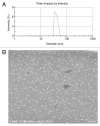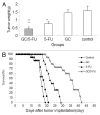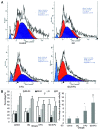Preliminary pharmacology of galactosylated chitosan/5-fluorouracil nanoparticles and its inhibition of hepatocellular carcinoma in mice
- PMID: 22954702
- PMCID: PMC3542231
- DOI: 10.4161/cbt.22001
Preliminary pharmacology of galactosylated chitosan/5-fluorouracil nanoparticles and its inhibition of hepatocellular carcinoma in mice
Abstract
Biodegradable polymer nanoparticle drug delivery systems are characterized by targeted drug delivery, improved pharmacokinetic and biodistribution, enhanced drug stability and lowered side effects; these drug delivery systems are widely used for delivery of cytotoxic agents. The galactosylated chitosan (GC)/5-fluorouracil (5-FU) nanoparticle is a nanomaterial made by coupling GC, a polymer known to have the advantages described above, and 5-FU. The GC/5-FU nanoparticle is a sustained release system, it was showed that the peak time, half-life time, mean residence time (MRT) and area of under curve (AUC) of GC/5-FU were longer or more than those of the 5-FU group, but the maximum concentration (Cmax) was lower. The distribution of GC/5-FU in vivo revealed the greatest accumulation in the hepatic cancer tissues, and the hepatic cell was the target of the nanoparticles. Toxicology research showed that the toxicity of GC-5-FU was lower than that of 5-FU in mice. In vivo experiments showed that GC/5-FU can significantly inhibit tumor growth in an orthotropic liver cancer mouse model. GC/5-FU treatment can significantly lower the tumor weight and increase the survival time of mice when compared with 5-FU treatment alone. Flow cytometry and the TUNEL assay revealed that compared with 5-FU, GC/5-FU caused higher rates of G 0-G 1 arrest and apoptosis in hepatic cancer cells.
Figures









Similar articles
-
Galactosylated chitosan/5-fluorouracil nanoparticles inhibit mouse hepatic cancer growth and its side effects.World J Gastroenterol. 2012 Nov 14;18(42):6076-87. doi: 10.3748/wjg.v18.i42.6076. World J Gastroenterol. 2012. PMID: 23155336 Free PMC article.
-
Synthesis of galactosylated chitosan/5-fluorouracil nanoparticles and its characteristics, in vitro and in vivo release studies.J Biomed Mater Res B Appl Biomater. 2012 Nov;100(8):2035-43. doi: 10.1002/jbm.b.32767. Epub 2012 Aug 2. J Biomed Mater Res B Appl Biomater. 2012. PMID: 22865703
-
5-Fluorouracil nanoparticles inhibit hepatocellular carcinoma via activation of the p53 pathway in the orthotopic transplant mouse model.PLoS One. 2012;7(10):e47115. doi: 10.1371/journal.pone.0047115. Epub 2012 Oct 15. PLoS One. 2012. PMID: 23077553 Free PMC article.
-
In vitro and in vivo evaluation of macromolecular prodrug GC-FUA based nanoparticle for hepatocellular carcinoma chemotherapy.Drug Deliv. 2017 Nov;24(1):459-466. doi: 10.1080/10717544.2016.1264499. Drug Deliv. 2017. PMID: 28219253 Free PMC article.
-
Synthesis of Biotin-Modified Galactosylated Chitosan Nanoparticles and Their Characteristics in Vitro and in Vivo.Cell Physiol Biochem. 2018;50(2):569-584. doi: 10.1159/000494169. Epub 2018 Oct 11. Cell Physiol Biochem. 2018. PMID: 30308481
Cited by
-
Chitosan Nanoparticles for Therapy and Theranostics of Hepatocellular Carcinoma (HCC) and Liver-Targeting.Nanomaterials (Basel). 2020 Apr 30;10(5):870. doi: 10.3390/nano10050870. Nanomaterials (Basel). 2020. PMID: 32365938 Free PMC article. Review.
-
Anti-cancer efficacy of biotinylated chitosan nanoparticles in liver cancer.Oncotarget. 2017 Jul 10;8(35):59068-59085. doi: 10.18632/oncotarget.19146. eCollection 2017 Aug 29. Oncotarget. 2017. PMID: 28938619 Free PMC article.
-
Self-Activated Cascade-Responsive Sorafenib and USP22 shRNA Co-Delivery System for Synergetic Hepatocellular Carcinoma Therapy.Adv Sci (Weinh). 2021 Jan 15;8(5):2003042. doi: 10.1002/advs.202003042. eCollection 2021 Mar. Adv Sci (Weinh). 2021. PMID: 33717848 Free PMC article.
References
-
- Namikawa T, Fukudome I, Kitagawa H, Okabayashi T, Kobayashi M, Hanazaki K. Plasma diamine oxidase activity is a useful biomarker for evaluating gastrointestinal tract toxicities during chemotherapy with oral fluorouracil anti-cancer drugs in patients with gastric cancer. Oncology. 2012;82:147–52. doi: 10.1159/000336799. - DOI - PubMed
-
- Sakata Y, Komatsu Y, Takagi S, Saitoh S, Itoh T, Suzuki H, et al. Randomized controlled study of mitomycin C/carboquone/5-fluorouracil/OK-432 (MQ-F-OK) therapy and mitomycin C/5-fluorouracil/doxorubicin (FAM) therapy against advanced liver cancer. Cancer Chemother Pharmacol. 1989;23(Suppl):S9–12. doi: 10.1007/BF00647230. - DOI - PubMed
-
- Kanetaka K, Enjoji A, Furui J, Nagata Y, Fujioka H, Shiogama T, et al. The Nagasaki Study Group for Digestive Organ Cancer Chemotherapy Effects of Intermittent 5-Fluorouracil and Low-dose Cisplatin Therapy on Advanced and Recurrent Gastric Cancer. Anticancer Res. 2012;32:3495–9. - PubMed
Publication types
MeSH terms
Substances
LinkOut - more resources
Full Text Sources
Miscellaneous
